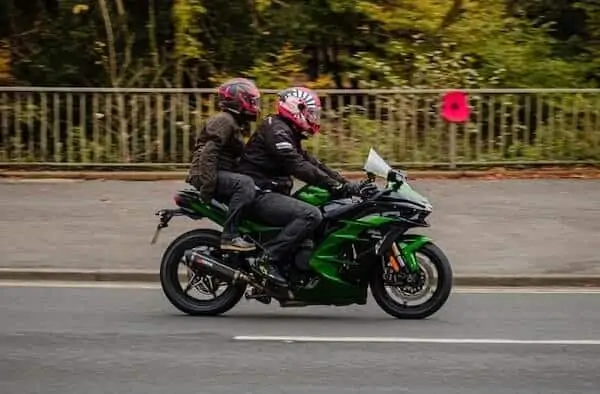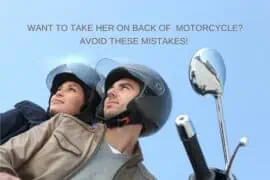I can still hear my stepfather’s lecture ring in my head after our first motorcycle ride together. “You can’t shift positions without telling me! Lean into the turn, hold on tight, and never take off that helmet.”
“Yes, sir,” I remember mumbling at the time. I was seven years old.
Didn't You Try Our Quote Comparison Tool Yet? Save BIG by Doing it!
“You need to take this seriously,” he said. “It’s just you and me out there, and a little shift is all it takes for us to get into trouble.”
I thought he was just trying to establish his family authority at the time. As I got older and we did more rides, I discovered there is a need to be a good motorcycle passenger to help you stay safe on the road.
Table of Content
What Can I Do to Become a Better Passenger?
The best thing you can do when riding as a passenger is to wear the appropriate safety gear. Even the safest operators can encounter unexpected circumstances, so you must be prepared for what might happen.
Start with respecting the passenger laws your state sets for you.
Your protective gear should include a DOT-approved helmet, long sleeves, pants, closed-toe shoes, and gloves. Some passengers prefer to ride with body armor or motorcycle airbags. Just let the operator know what you plan to have so they can prepare for the ride.
Here are some other tips that can help you become a better passenger while enjoying the open road.
Establish Clear Communication
Before the ride, discuss hand signals or verbal cues with the rider to establish effective communication. Agree on calls for acceleration, deceleration, turns, and stops.
I prefer hand signals because there is less to misinterpret with them. Here are some examples to consider establishing if you’re a motorcycle passenger.
- Tap the rider’s shoulder to indicate a turn in that direction.
- Extend your left or right hand and point in the intended direction for turns.
- Tap the rider’s shoulder twice to indicate a stop.
- Thumbs up to signify that everything is okay.
During quiet moments, simple verbal cues can communicate what is needed, just as “lean left” or “stopping now.”
Find a Comfortable Position
Sit as far forward as possible without interfering with the rider’s control. Keep your feet on the foot pegs or passenger floorboards and your hands on the rider’s waist or the grab rails, if available.
It would be best to be comfortable because any shifting during the operation could destabilize the motorcycle. Try to maintain a relaxed body position and avoid leaning excessively in the opposite direction of the bike’s lean.
The best way to stay balanced is to keep your body in line with the operator’s movements.
Anticipate What Could Happen
Pay attention to the road ahead and anticipate the operator’s actions. When you stay in the moment and understand the circumstances, this tip will help you prepare for acceleration, braking, and turns, making the ride smoother.
Look in the direction of the turn with your gaze over the operator’s shoulder. This technique helps you anticipate the next move and maintain balance. Don’t look down or to the side; those actions can affect your stability.
Practice Good Etiquette
Be a courteous passenger by avoiding sudden movements, shouting, or unnecessary fidgeting. Respect the rules of the road and maintain good etiquette.
That starts with being ready to ride on time. Respecting the operator’s schedule and plans is always an excellent start to the day. Keep your focus on the ride, and avoid using electronic devices that can divert your attention.
No one is always expected to hold the same position. If you need to shift, communicate with the operator so that they’re prepared for possible handling changes.
Finally, think about showing appreciation to the operator for taking you along on the ride. A simple thank you can go a long way in acknowledging their efforts.
What If I’m a Passenger in a Sidecar?
Motorcycle sidecars can be very sensitive to weight distribution. Sit still and maintain a balanced posture within the sidecar to help with stability and handling while avoiding sudden movements or unnecessarily shifting your weight.
Lean your body toward the turn to help balance the sidecar and maintain stability.
Any bags or personal items should be securely stored in the sidecar. If these things shift, it could affect the motorcycle’s handling.
Sidecars can be affected by wind more than motorcycles. Be aware of the wind conditions and how they may impact the stability of the sidecar, holding on securely and adjusting your body position when adverse conditions exist.
Don’t Forget to Have Fun Out There!
Exploring the open road on a motorcycle provides a feeling like nothing else. As a passenger, you share that experience while enjoying the moments the highways or city streets offer.
Most importantly, have fun with the feeling that the freedom of the road brings. You might even consider investing in your own motorcycle one day to enjoy these experiences more!
Use This Tool for Free and Save on Quotes!






